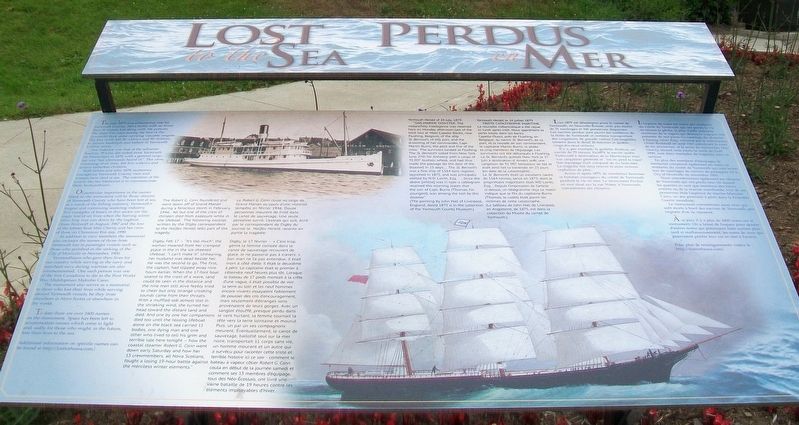Lost to the Sea / Perdus en Mer
The year 1879 was a disastrous one for Yarmouth County, Nova Scotia, with no fewer than 31 vessels lost along with 106 persons. The ships lost were among the best of the Yarmouth fleet, some carrying valuable cargoes. The loss of life left 26 widows and 99 children to mourn husbands and fathers in Yarmouth County alone.
One instance was that of the schooner Boadicea, 79 tons; she sailed from Yarmouth for Martinique in 1879, with a general cargo, but was "not afterwards heard of." Her crew, consisting of six men, left five widows and sixteen fatherless children.
Both before and after 1879, numerous courageous Yarmouth County men and women have died at sea. The intention of the Lost to the Sea Memorial is to commemorate these Yarmouthians.
Of particular importance in the names listed on the monument will be those citizens of Yarmouth County who have been lost at sea as a result of the fishing industry, Yarmouth's longest and continuing seafaring industry. Two examples of losses in this sector are the tragic loss of six lives when the herring seiner Silver King was run down by the tugboat Ocean Rockwift in August 1967; and the loss of the lobster boat Miss Charity and her crew of three on Christmas Eve day, 1990.
In addition to crew members the memorial also includes the names
of those from Yarmouth lost in passenger vessels such as those who perished in the sinking of the City of Monticello in November, 1900.Yarmouthians who gave their lives for our country while serving in the navy and merchant navy during wartime are also commemorated. One such person was one of the first Canadians to die in the First World War, Midshipman Malcolm Cann.
The monument also serves as a memorial to those who lost their lives while serving aboard Yarmouth vessels, be they from elsewhere in Nova Scotia or elsewhere in the world.
To date there are over 2400 names on the monument. Space has been left to accommodate names which come to light and, sadly, for those who might, in the future, lose their lives to the sea.
Additional information on specific names can be found at http://losttothesea.com/.
[Illustration captions read]
• The Robert G. Cann foundered and went down off of Grand Manan during a ferocious storm in February, 1946. All but one of the crew of thirteen died from exposure while in the lifeboat. The following excerpt, written by the Digby correspondent to the Halifax Herald, tells part of the tragedy:
Digby, Feb 17 - "It's too much", the woman moaned from her cramped place in the ice-sheeted lifeboat. "I can't make it". Unhearing, her husband was dead beside her. He was the second to go. The first,
the captain, had slipped away nine hours earlier. When the 17-foot boat soared to the crest of a wave, land could be seen in the distance and the nine men still alive feebly tried to cheer but only strange croaking sounds came from their throats. With a muffled sob almost lost in the shrieking wind, she turned her head toward the distant land and died. And one by one her companions died too until the tossing lifeboat alone on the black sea carried 11 bodies, one dying man and one other who lived to tell his grim and terrible tale here tonight - how the coastal steamer Robert G. Cann went down early Saturday and how her 13 crewmembers, all Nova Scotians, fought a losing 19-hour battle against the merciless winter elements."
• Yarmouth Herald of 24 July, 1879:
"SAD MARINE DISASTER. The melancholy intelligence was received here on Monday afternoon last of the total loss at West Capelle Banks, near Flushing, Belgium, of the ship St. Bernard's, of this port, and the drowning of her commander, Capt. Martin Burns, the pilot and five of the crew. The survivors landed at Flushing. The St. Bernard's sailed from New York June 27th for Antwerp with a cargo of 91,907 bushels wheat, and had thus made the passage (to the date of the disaster) in 23 days.... The St. Bernard's was a fine ship of 1564 tons register, launched in 1875, and was principally
(The painting by John Hall of Liverpool, England, dated 1875 is in the collection of the Yarmouth County Museum.)
[French]
L'an 1879 est désastreux pour le comté de Yarmouth, en Nouvelle-Écosse, avec pas moins de 31 naufrages et 106 personnes disparues. Les navires perdus sont parmi les meilleurs de la flotte de Yarmouth et certains transportent des cargaisons de grande valeur. Ces tragédies laissent dans le deuil 26 femmes et quarte-vingt-dix-neuf enfants.
Il y a, par exemple, la goélette Brodicea [sic - Boadicea], un navire de 79 tonnes. En 1879, le navire quitte Yarmouth à destination de la Martinique avec une cargaison générale et "on en perd la trace". Son équipage était composé de six hommes. La tragédie fait cinq veuves et seize enfants orphelins de père.
Avant et après 1879, de nombreux hommes et femmes courageux du comté de Yarmouth perdent la vie en mer. Le monument Perdus en mer situé sur la rue Water, à Yarmouth, commémore ces citoyens.
Il importe de noter les noms des résidants du comté de Yarmouth qui ont perdu la vie en faisant la pêche, la plus vieille industrie maritime de la région qui demeure toujours très présente de nos jours. Le naufrage du chalutier à hareng Silver King, renversé par le remorqueur Ocean Rockswift en août 1967, entraînant la mort de six personnes, et la perte du homardier Miss Charity, faisant trois morts la veille de Noël 1990, sont deux exemples de tragédies dans ce secteur.
En plus des membres d'équipages, le mémorial comprend également les noms de résidants du comté de Yarmouth qui sont morts lors de naufrages de navires de passagers, tel le City of Monticello en novembre 1900.
Nous commémorons également les citoyens de Yarmouth qui ont perdu leur vie durant les guerres en tant que membres des forces armées ou de la marine marchande. Une de ces personnes était l'aspirant de marine Malcolm Cann, un des premiers à périr dans la Première Guerre mondiale.
Le monument commémore aussi ceux qui sont morts à bord des navires de Yarmouth, peu importe d'où ils venaient.
À ce jour, il y a plus de 2400 noms sur le monument. On a laissé de l'espace pour ajouter d'autres noms qui pourraient faire surface plus tard et malheureusement, les noms de ceux qui pourraient perdre leur vie en mer à l'avenir.
Pour plus de renseignements visitez le http://losttothesea.com/.
[Légende des illustrations lues]
• Le Robert G. Cann coule au large de Grand Manan au cours d'une violente tempête en février 1946. Douze personnes meurent de froid dans le canot de sauvetage. Une seule personne survit. L'extrait qui suit, écrit par le correspondant de Digby du journal le Halifax Herald, raconte en partie la tragédie:
Digby, le 17 février - « C'est trop, gémit la femme coincée dans le canot de sauvetage recourvert de glace. Je ne passerai pas à travers. » Son mari ne l'a pas entendue, il était mort à côté d'elle. Il était le deuxième à périr. Le capitaine était le premier à s'éteindre neuf heures plus tôt. Lorsque le bateau de 17 pieds montait à la crête d'une vague, il était possible de voir la terre au loin et les neuf hommes encore vivants essayaient faiblement de pousser des cris d'encouragement, mais seulement d'étranges sons provenaient de leurs gorges. Avec un sanglot étouffé, presque perdu dans le vent hurlant, la femme tournait la tête vers la terre lointaine et mourut. Puis, un par un ses compagnons meurent. Éventuellement, le canot de sauvetage, ballotté seul sur la mer noire, transportait 11 corps sans vie, un homme mourant et un autre qui a survécu pour raconter cette triste et terrible histoire ici ce soir - comment le bateau à vapeur côtier Robert G. Cann coula en début de la journée samedi et comment ses 13 membres d'équipage, tous des Néo-Écossais, ont livré une vaine bataille de 19 heures contre les éléments impitoyables d'hiver.
• Yarmouth Herald, le 24 juillet 1879
TRISTE CASTASTROPHE MARITIME. La nouvelle mélancolique a été reçue ici lundi après-midi. Nous apprenions la perte totale dans les bancs Capelle-Ouest, près de Flushing, en Belgique, du navire St. Bernard's, de ce port, et la noyade de son commandant, le capitaine Martin Burns, le pilote et cinq membres de l'équipage. Les survivants ont été débarqués à Flushing. Le St. Bernard's quittait New York le 27 juin à destination d' Anvers avec une cargaison de 91 907 boisseaux de blé et avait ainsi fait la traversée en 23 jours (en date de la catastrophe)... Le St. Bernard's était un excellent navire de 1564 tonnes, lancé en 1875, dont le propriétaire majoritaire était WD Lovitt, Esq... Depuis l'impression de l'article ci-dessus, un télégramme reçu ce matin indique que le fils du capitaine Burns (Thomas, le cadet) était parmi les victimes de cette catastrophe. (Le tableau de John Hall de Liverpool, en Angleterre, de 1875, est dans la collection du Musée du comté de Yarmouth.)
Topics and series. This historical marker is listed in these topic lists: Disasters • Industry & Commerce • Waterways & Vessels. In addition, it is included in the Lost at Sea series list. A significant historical year for this entry is 1879.
Location. 43° 50.317′ N, 66° 7.253′ W. Marker is in Yarmouth, Nova Scotia, in Yarmouth County. Marker is at the intersection of Water Street and Glebe Street, on the right when traveling north on Water Street. Touch for map. Marker is at or near this postal address: SW Edge of Frost Park, Yarmouth NS B5A 1G2, Canada. Touch for directions.
Other nearby markers. At least 8 other markers are within walking distance of this marker. Lost to the Sea (a few steps from this marker); Sarah Corning (within shouting distance of this marker); Hartlin Trail (within shouting distance of this marker); First Yarmouth Mayor and Council (within shouting distance of this marker); Cape Forchu Lighthouse (about 90 meters away, measured in a direct line); Frost Park (about 90 meters away); a different marker also named Frost Park (about 90 meters away); War Memorial (about 120 meters away). Touch for a list and map of all markers in Yarmouth.
Related markers. Click here for a list of markers that are related to this marker.
Also see . . . Lost to the Sea Memorial, Yarmouth, Nova Scotia. (Submitted on September 4, 2017, by William Fischer, Jr. of Scranton, Pennsylvania.)
Credits. This page was last revised on September 4, 2017. It was originally submitted on September 4, 2017, by William Fischer, Jr. of Scranton, Pennsylvania. This page has been viewed 190 times since then and 11 times this year. Photos: 1, 2. submitted on September 4, 2017, by William Fischer, Jr. of Scranton, Pennsylvania.

